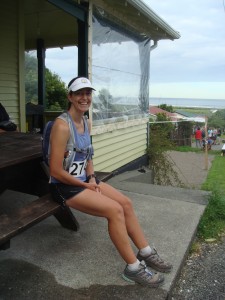
I was all smiles before the start of the Croesus Crossing because I was clueless about the terrain we faced.
Two days have passed since Morgan and I finished the Croesus Crossing trail event on the West Coast of New Zealand, and we’re still looking at each other stupefied and using expressions like, “Can you believe …?” and “What was that?” I’m grateful that he was with me to corroborate the technical difficulty of the course and the abnormal adroitness of the other runners. We feel a bit like anthropologists who spied a new breed of trail runner here in the jungle-like bush of the South Island.
Long story short: We got our butts kicked. We were unprepared for the difficulty and humbled by the hard-core agility of the others.
“Did you enjoy it?” someone asked me. No, I can’t say I did. But it was a learning experience.
(Hitting your head with a hammer also could be called a learning experience: Don’t do it again.)
Recently, here and on our Away Together travel blog, I’ve been raving about New Zealand trail running. There are beautiful, well-maintained trails (called “tracks”) crisscrossing the country’s national parks. We thought the Croesus Crossing would be like the other tracks we’ve run here, with mostly level footing and well marked. We were wrong.
The course goes from the tiny coastal town of Barrytown, near Greymouth, over a mountain in the Paparoa Range, and ends at another tiny town called Blackball. Race organizers Nelson Events advertise it as 26K (16.1 miles), but my Garmin — which typically underestimates distance on very vertical routes — measured it as 17.4 miles, so I’d call it a 28K.
The race website doesn’t list the elevation, but somewhere we saw a figure of the summit being around 1200 meters high. In the back of my mind I computed that this would be nearly 4,000 feet of climbing in about the first seven miles, since it starts near sea level — roughly the equivalent of running Mount Diablo straight up rather than on switchbacks — but I refused to believe it. I was lulled into complacency in part by the description on the New Zealand Trampers website that says, “This pretty and easy walk through historic gold country climbs gently over the eroded Paparoa Ranges between Blackball and Barrytown on the West Coast.” It turns out that description is based on starting at the relatively easier Blackball side, which we descended — but to use the word “easy” to describe this route is like calling the Dipsea “gentle.”
Another tip-off to the difficulty should have been the course record times of around three hours for women. Three hours to go 16 miles? That’s an average pace of 11:15 — a slow jog. I mistakenly concluded that the event must not attract a very competitive field. I thought back on the 17-mile Imogene Pass Run in Colorado last September, which climbs about 5300 feet in the first 10 miles in very thin air, and recalled that I finished it in 3:25. I thought for sure the Croesus Crossing couldn’t be harder than Imogene, especially since it allegedly would be a mile shorter, so I felt that breaking 3:30 would be quite doable.
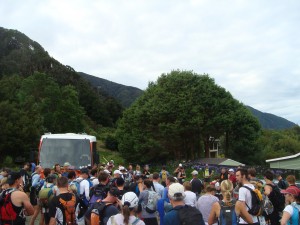
The briefing before the start of the Croesus Crossing. We were admonished to carry enough protective gear to survive a bad storm, even on a fairly sunny day.
The field is limited to 100, and a total of 89 started the race this year. Morgan and I noticed right away that the other 87 looked very fit and fairly young — mostly in their 20s and 30s — and there were hardly any gray-haired old-timers like we normally see at California trail events.
The race is mostly unsupported — just two water stations, both of them after the summit — and severe weather is a real threat, so the race organizers are strict about gear requirements and checked all runners to make sure we each had enough water and protective layers to take care of ourselves if a storm should erupt. Morgan and I each carried a waterproof jacket, gloves, woolen hat, whistle, safety blanket and plenty of water. It was a relatively warm and dry day, so we probably would not need to use any of the layers, but they still flagged us for not meeting the requirement of carrying a long-sleeve fleece shirt. Fortunately, they had ones we could borrow, so we stuffed them into our packs and began the race feeling quite loaded down. (Oddly, the race organizers didn’t stress the importance of carrying enough calories. Thankfully I had enough gel and a bar to get me through. Morgan ran out midway but happened to find a tube of energy gel that another runner had dropped, which saved him.)
The race started on a tight, slick single track of switchbacks in a forest of fern and beech trees. I scrambled as quickly as I could so as not to hold up the line, and I managed what felt like a strong start in spite of the steep ascent. Then I looked at my watch after the first two miles and saw I was averaging about 14 minutes per mile. It can’t get slower than this, I thought. Oh, how wrong I was.
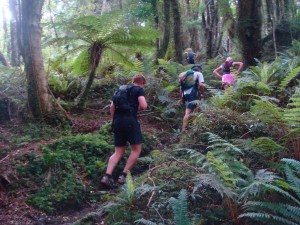
Morgan shot this in the early part of the race. The ascent grew much steeper and the footing much more difficult. He stopped taking photos until the summit because the hiking and climbing took all his concentration.
Over the next hour and a half, my pace slowed to about 24 minutes per mile — slower than a regular walk — as I struggled to step up and over tree roots that protruded like uneven rungs on a ladder-like trail. I was glad all my water was on my back rather than in hand-held bottles, because I needed both hands to grab ferns and tree branches to help pull myself up. The trail frequently faded from view, obscured by flax and fern leaves, and at one point I wandered into tangled bush for about 30 feet until I realized my mistake. Meanwhile, other runners were coming up behind me, and I moved aside to let them pass. As a lifelong equestrian with a lot of experience riding on wilderness trail, it occurred to me that this was the first trail I’ve ever tried to run that I would deem too hazardous for a horse.
Finally we reached a flatter area that plunged downhill a ways before going back up to the summit. This was a particularly discouraging stretch for me because I got passed by a pack of about ten runners, mostly women, who seemed unfazed by the tripping hazards. They flew over the roots and rocks with total confidence while I hesitated and picked my way step by step. I was trying my best and being as gutsy as I could be; I just wasn’t nearly as good at navigating the terrain as the others. I realized I was witnessing the trail skills honed in a country where “tramping” (what Kiwis call hiking) is a national pastime and Sir Edmund Hillary is a national hero.
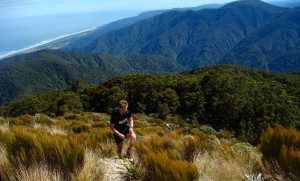
Morgan snapped this shot of runners approaching the summit. The race started way down by the coastline! At least we were blessed with clear blue skies.
The forest suddenly subsided and we emerged on a shrubby summit where the wind blasted sideways. I paused to take in the view but mostly concentrated on running the ridge to make up time on a blissfully runnable stretch of trail. The smooth footing disappeared, however, as soon as we began the descent. Ankle-twisting rocks the size of tennis balls or bigger led the way down. More and more people passed me — too many to keep track of — but I tried to stay positive and keep doing my best. We eventually reached an area where the track widened and felt more like a road, but again the relief was short lived. At times the trail disappeared into a creek bed — because the trail was in fact the creek bed, and we had to slosh through the runoff. Both my big toes were giant blisters and my feet ached from the sharp rocks underfoot.
We reached the end of the trail after about 13.5 miles — which included a brutal uphill from the riverbed in the trail’s last stretch — but we still had another 7K (about 4 miles) until the finish line, which is at the historic Blackball Hilton hotel and pub. Ah haa, I thought, now this is what I’m trained for! While several runners around me wilted and bonked once we hit the road, I finally found my mojo and vowed to run the whole way back. The final stretch includes a tough half-mile uphill and two shorter hills in direct sun, but I ran strong the final stretch and passed several of those who overtook me on the mountain.
More than an hour ahead of me, men’s winner Matt Scott crossed the finish line in 2:51 and women’s winner Helen Gillespie finished in 3:17 (9th overall). Now I know why it’s a big deal to break 3 hours on this course. I gave it my best and sprinted at the end but still finished in a new personal worst time for the distance: 4:06! I ended up 48th out of 89 overall, and 11th out of 33 women.
Boy was I glad to finish — and to see my smiling kids safe and happy. (They spent the morning basically on their own at the pub/hotel where we spent the night, but that’s another story, which I wrote about on our travel blog).
I couldn’t really relax, though, until Morgan finished and I was sure he was okay. I pictured him bonking from lack of calories or spraining his ankle or both.
About 40 minutes after I finished, I began to backtrack on the course and thankfully spotted Morgan coming down the last half mile. He was jogging stiffly and slightly bowlegged from excruciating chaffing on his inner thighs. I called out to him to finish strong, but he shook his head. “I’ve got one gear left, and this is it,” he called back. He caught up to me and we jogged the last stretch together. “That’s the hardest thing I’ve ever done, no question about it,” he said matter-of-factly as we shuffled along. His eyes looked sunken, and dried sweat and sunscreen gave his face a ghostly pallor. Did my husband really age 20 years in about four hours? Then, thank goodness, he perked up and smiled when Colly and Kyle ran toward him gleefully and accompanied him through the finish line. He crossed in 4:48, 72nd overall.
I couldn’t believe how cheerful and spunky most of the other participants seemed after the race. Seeing their spirit and skill, and getting to know the community around Blackball, ultimately made the whole experience worthwhile — but would I recommend it to other trail-running tourists? I’m not sure I’d go that far. But if you, too, decide to travel halfway around the world and detour to the middle of nowhere on the West Coast of New Zealand for this mountain masochism, then as they say here, “Good on ya!”

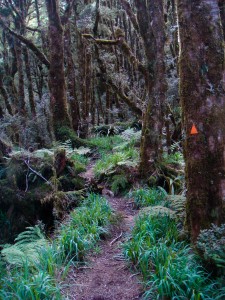
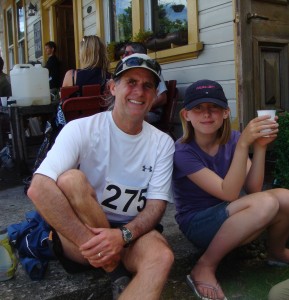
I love your account of this event. It makes me realise that there is a differnce between what we New Zealanders call Trail running and what North Americans are used to. I love the rough tracks and even the river bed running – as I believe a lot of Kiwis do. It must be the years of tramping/hiking and mucking around in the bush that ‘give our feet eyes’. Your obvious focus on time per mile becomes irrelevant in this terrain. Congratulations on doing the run as you describe it, it was real tough challenge and for us Kiwis it makes it all the more desirable to participate in the next one.
You guys are nuts. That photo that Morgan snapped from the summit says it all (esp. given that the second runner below the first one give a real sense of how steep the ascent must have been–not to mention the distance to the coastline).
Congratulations on putting this one behind you!
–David
Great account and one that mirrors my own experience being second from last ! 5 hours 24 I believe !The results keep appearing and vanishing from the website. I am looking forward to seeing the pics when they are eventually available.
For me it was my first 26K distance and third trail-running race both of which were around 22K (The flagpole run – run up for Avalanche peak & the Moa run)
The surface for running just destroyed me – like you I could not believe how that course could be run and the skills of competitors able to move fast over such terrain. Sure does re-define what a trail is ! Once I hit tarmac I did find I could open up a bit 🙂
Unfortunately I picked up a throat infection post the race and the Avalance Peak beckons but I know what surfaces I need to train and concentrate on now.
Great blog Sarah and good luck with the rest of your travels 🙂
I see you have both enjoyed a quite run over the Paparoa,s, I do hope you enjoyed the view in between pant’s of air.The vista of Mount Cook was only just visable through the haze above the snow line on the top’s but the Grey valley was sensational on your descent through the beech forest. Don’t you just feel so lucky to have experienced such an emotion.Now you know why NZ is refered to as Gods Own.
You can view your pictures on http://www.paulwebster.co.nz and have put more of a perspective of the terrain, you are right, reasonably tough but acheivable, cheers Paul
Paul – thanks for the comment above and the link to your photos.
If you click on http://www.paulwebster.co.nz, click Croesus Crossing, the photos of me are #67 and 68, and Morgan is 100 and 110.